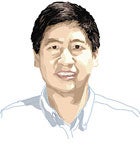
JONATHAN FENG is a theoretical physicist working at the intersection of particle physics and cosmology, with a focus on dark matter. Currently a professor of physics and astronomy at the Univ. of California, Irvine, he played the trumpet in a former life.

MARK TRODDEN studies particle physics and cosmology. He is co-director of the Center for Particle Cosmology at the Univ. of Pennsylvania and an author of Cosmic Variance, a leading physics blog. When not pondering the cosmos, he can often be found sipping wine in a busy kitchen.
Dark Forces, Hidden Worlds
Once one admits the possibility of hidden particles with properties that go beyond the standard WIMP scenario, it is natural to consider the full range of possibilities. Could there be a whole sector of hidden particles? Could there be a hidden world that is an exact copy of ours, containing hidden versions of electrons and protons, which combine to form hidden atoms and molecules, which combine to form hidden planets, hidden stars and even hidden people?
The idea is truly tantalizing. Could it be that what we see as dark matter is really evidence for a hidden world that mirrors ours? And are hidden physicists and astronomers even now peering through their telescopes and wondering what their dark matter is, when in fact their dark matter is us?
Unfortunately, basic observations indicate that hidden worlds cannot be an exact copy of our visible world. For one, dark matter is six times more abundant than normal matter. For another, if dark matter behaved like ordinary matter, halos would have flattened out to form disks like that of the Milky Way—with dramatic gravitational consequences that have not been seen. Last, the existence of hidden particles identical to ours would have affected cosmic expansion; compositional measurements rule that out. These considerations argue strongly against hidden people.
That said, the dark world might indeed be a complicated web of particles and forces. In one line of research, several investigators, including one of us (Feng) and Jason Kumar of the University of Hawaii at Manoa, have found that the same supersymmetric framework that leads to WIMPs allows for alternative scenarios that lack WIMPs but have multiple other types of particles. What is more, in many of these WIMP—less theories, these particles interact with one another through newly postulated dark forces. We found that such forces would alter the rate of particle creation and annihilation in the early universe, but again the numbers work out so that the right number of particles are left over to account for dark matter. These models predict that dark matter may be accompanied by a hidden weak force or, even more remarkably, a hidden version of electromagnetism, implying that dark matter may emit and reflect hidden light.
This "light" is, of course, invisible to us, and so the dark matter remains dark to our eyes. Still, new forces could have very significant effects. For example, they could cause clouds of dark particles to become distorted as they pass through one another. Astronomers have searched for this effect in the famous Bullet Cluster, which consists of two clusters of galaxies that have passed through each other. Observations, however, show that the brief co-mingling of clusters left the dark matter largely unperturbed, indicating that any dark forces could not be very strong (view Bullet Cluster Movie on next page).
The idea is truly tantalizing. Could it be that what we see as dark matter is really evidence for a hidden world that mirrors ours? And are hidden physicists and astronomers even now peering through their telescopes and wondering what their dark matter is, when in fact their dark matter is us?
Unfortunately, basic observations indicate that hidden worlds cannot be an exact copy of our visible world. For one, dark matter is six times more abundant than normal matter. For another, if dark matter behaved like ordinary matter, halos would have flattened out to form disks like that of the Milky Way—with dramatic gravitational consequences that have not been seen. Last, the existence of hidden particles identical to ours would have affected cosmic expansion; compositional measurements rule that out. These considerations argue strongly against hidden people.
That said, the dark world might indeed be a complicated web of particles and forces. In one line of research, several investigators, including one of us (Feng) and Jason Kumar of the University of Hawaii at Manoa, have found that the same supersymmetric framework that leads to WIMPs allows for alternative scenarios that lack WIMPs but have multiple other types of particles. What is more, in many of these WIMP—less theories, these particles interact with one another through newly postulated dark forces. We found that such forces would alter the rate of particle creation and annihilation in the early universe, but again the numbers work out so that the right number of particles are left over to account for dark matter. These models predict that dark matter may be accompanied by a hidden weak force or, even more remarkably, a hidden version of electromagnetism, implying that dark matter may emit and reflect hidden light.
This "light" is, of course, invisible to us, and so the dark matter remains dark to our eyes. Still, new forces could have very significant effects. For example, they could cause clouds of dark particles to become distorted as they pass through one another. Astronomers have searched for this effect in the famous Bullet Cluster, which consists of two clusters of galaxies that have passed through each other. Observations, however, show that the brief co-mingling of clusters left the dark matter largely unperturbed, indicating that any dark forces could not be very strong (view Bullet Cluster Movie on next page).
If the super-WIMP hypothesis is correct then it is possible that what was actually created in those first nano-seconds was an entire parallel world of particles - electrons and protons, forming atoms and molecules, and hidden from us because the only connection is gravity. It does not require a huge leap in imagination to realize that such a hidden parallel world of matter could equally be populated by hidden stars, planets and even life.














 WHERE DARK MATTER CAME FROM
WHERE DARK MATTER CAME FROM


